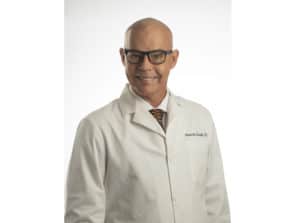View Larger Image

Lee Butler with her grandchildren, Emily and Andrew.
Scarless Hysterectomy Gives Sherwood Woman Peace of Mind
| Lee Butler loves to garden. Her family and her neighbors all enjoy the abundant foliage of hosta plants and ferns as well as the blooms on the rose and azalea bushes surrounding her Sherwood home.
“People ask me how I have time to make them all so beautiful. I tell them, “It didn’t start out this way. It took some work!”
Butler is no stranger to challenges. She’s raised three children, experienced the loss of an adult child and survived cancer. She has two grandchildren, her “G Babies” she kept up with as they were growing up. Emily is 20 now and Andrew is 17.
In March 2019, Butler noticed blood on her toilet paper. She thought she may have scratched herself. But it came back a few weeks later. So she called her physician.
“My doctor told me he starts with the assumption that it is cancer, then works to prove it is not,” Butler said. “He did a pelvic exam and an endometrial biopsy. I take pain pretty well. But that hurt badly, even days later.”
Her physician referred her to Alexander Burnett, M.D., a gynecologic surgeon at UAMS.
“I wanted a second opinion about on whether I should see Dr. Burnett,” Butler said. “So I called another doctor who said, ‘Oh, that is definitely who we would have referred you to as well.’ So, I thought, ‘Dr. Burnett it is!’”
Butler had endometrial cancer. Burnett said she would need a hysterectomy and that she was a candidate for a relatively new minimally invasive approach.
Burnett is one of only a handful of surgeons worldwide and the first in the United States at the cutting edge of a new scarless and almost painless technique for hysterectomy. The method is called Total Vaginal Natural Orifice Transluminal Endoscopic Surgery (V-NOTES) hysterectomy.

Gynecologic surgeon Alexander Burnett, M.D., is the first surgeon in the United States at the cutting edge of a new scarless and almost painless technique for hysterectomy called Total Vaginal Natural Orifice Transluminal Endoscopic Surgery (V-NOTES).
Hysterectomy, or removal of the uterus, is a common surgery for reproductive-age women in the United States, second only to cesarean section. Butler delivered three babies through cesarean section and has had a number of other surgeries, including one to remove lymph nodes from her lungs.
Traditionally, hysterectomies are performed via an incision to the abdomen, which requires a hospital stay of at least one or two days and a recovery period of a full six weeks before the patient can resume normal activities and physical exertion.
“With V-NOTES, the surgery is actually performed through the vaginal canal, so there are no incisions to the outside of the body that are visible after the surgery,” Burnett said.
Butler’s surgery was in June 2019. She was surprised there was hardly any pain at all following the procedure.
“This was by-far the easiest recovery I’ve ever had.”
“I called it ‘hotel UAMS’ because everyone was so nice and accommodating.”
Butler had a few follow-up appointments and is now back outdoors with her roses and azaleas, which she rearranges from time to time. That takes a lot of work from both her and her husband, but the payoff is worth it.
“I just love spending time out there. Sometimes I have to remind myself that I’ve had a hysterectomy. Part of me is gone, but I cannot tell.”
